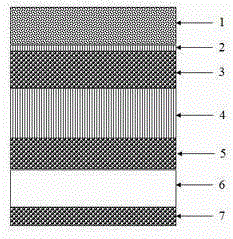PIN heterojunction solar cell and preparation method thereof
A solar cell and heterojunction technology, applied in circuits, photovoltaic power generation, electrical components, etc., can solve problems such as inability to mass-produce, and achieve the effects of improving time stability, conversion rate, and conversion efficiency
- Summary
- Abstract
- Description
- Claims
- Application Information
AI Technical Summary
Problems solved by technology
Method used
Image
Examples
Embodiment 1
[0032] 1) ITO (Indium Tin Oxides) conductive glass is used as the light-transmitting / transparent electrode layer;
[0033] 2) The NiO layer was prepared on the surface of conductive glass by spraying pyrolysis technology. The thickness is controlled at 15nm;
[0034] 3) According to the molar ratio of 2:1:6, a mixed solution of nickel acetone hexanoate, lithium acetate, and magnesium acetate tetrahydrate was prepared, spin-coated on the transition layer, and dried at 350°C to prepare an electron transport layer; thickness 15nm;
[0035] 4) Prepare light-absorbing layer:
[0036] a. prepare PbI2 solution, concentration is 2.3Mol / L, and solvent is dimethylformamide;
[0037] b. Prepare CH3NH3I solution: the concentration is 7.5mg / mL, and the solvent is isopropanol;
[0038] In-situ synthesis of perovskite materials by solution method: spin-coat PbI2 solution on the electron transport layer first, dry it and soak it in CH3NH3I solution to grow perovskite materials, and obtain p...
Embodiment 2
[0048] 1) Aluminum zinc oxide AZO conductive glass is used as the light-transmitting / transparent electrode layer;
[0049] 2) Prepare a NiO2 layer on the surface of conductive glass by spraying thermal decomposition technology; the thickness is 8nm;
[0050] 3) A mixed solution of nickel hexanoate acetone, lithium acetate, and magnesium acetate tetrahydrate was prepared according to the molar ratio of 1:1:3, spin-coated on the transition layer, and dried at 400°C to prepare the electron transport layer; thickness 60nm;
[0051] 4) Prepare light absorbing layer:
[0052] a. Prepare PbI2 solution, the concentration is 0.5Mol / L, and the solvent is dimethylformamide;
[0053] b. Prepare CH3NH3I solution: the concentration is 10 mg / mL, and the solvent is isopropanol;
[0054] In-situ synthesis of perovskite materials by solution method: spin-coat PbI2 solution on the electron transport layer first, dry it and soak it in CH3NH3I solution to grow perovskite materials, and obtain p...
Embodiment 3
[0064] 1) Aluminum zinc oxide AZO conductive glass is used as the light-transmitting / transparent electrode layer;
[0065] 2) Prepare a NiO2 layer on the surface of conductive glass by spraying thermal decomposition technology; the thickness is 50nm;
[0066] 3) According to the molar ratio of 1:1:5, a mixed solution of nickel hexanoate acetone, lithium acetate, and magnesium acetate tetrahydrate was prepared, spin-coated on the transition layer, and dried at 300°C to prepare the electron transport layer; thickness Controlled at 10nm;
[0067] 4) Prepare light absorbing layer:
[0068] a. Prepare PbI2 solution, the concentration is 1.5Mol / L, and the solvent is dimethylformamide;
[0069] b. Prepare CH3NH3I solution: the concentration is 8.5 mg / mL, and the solvent is isopropanol;
[0070] In-situ synthesis of perovskite materials by solution method: spin-coat PbI2 solution on the electron transport layer first, dry it and soak it in CH3NH3I solution to grow perovskite materi...
PUM
 Login to View More
Login to View More Abstract
Description
Claims
Application Information
 Login to View More
Login to View More - R&D
- Intellectual Property
- Life Sciences
- Materials
- Tech Scout
- Unparalleled Data Quality
- Higher Quality Content
- 60% Fewer Hallucinations
Browse by: Latest US Patents, China's latest patents, Technical Efficacy Thesaurus, Application Domain, Technology Topic, Popular Technical Reports.
© 2025 PatSnap. All rights reserved.Legal|Privacy policy|Modern Slavery Act Transparency Statement|Sitemap|About US| Contact US: help@patsnap.com

